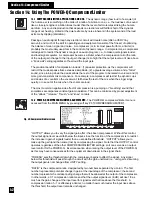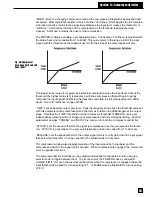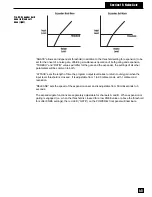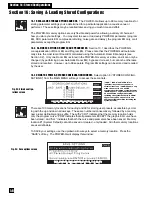
34
3. Select soft key #3 ("FBX and PARAMETRIC FILTERS") from the MAIN MENU, and make any
adjustments to the default configurations.
4. Slowly raise the gain (for one channel only). As feedback begins to occur, the FBX filters will
automatically detect the correct feedback frequency and apply a narrow filter to eliminate it.
Continue raising the gain until all FBX fixed filters are set. If you wish to lock the FBX fixed
filters to prevent them from notching more deeply, press the "LOCK+/-" soft key at the right of
the screen so it reads "LOCK+."
5. Repeat this procedure for the other channel.
Turbo Setup notes: Here is a step-by-step guide to using the Turbo function:
1-3. Follow steps 1-3 as above.
4.
Press the “Turb+/-” soft key, to open up the Turbo screen, as shown:
5.
Highlight “Turbo” using the arrow keys.
6.
Slowly raise the gain (for one channel only). As feedback begins to occur, the FBX
filters will automatically detect the correct feedback frequency and apply a narrow filter to
eliminate it. Continue raising the gain until all FBX fixed filters are set. If you wish to lock
the FBX fixed filters to prevent them from notching more deeply, press the "LOCK+/-" soft
key at the right of the screen so it reads "LOCK+."
7.
Repeat this procedure for the other channel.
Auto Turbo Setup notes: With Auto Turbo Setup follow these steps:
1-3. Follow steps 1-3 of normal FBX setup.
4.
Press the “Turb+/-” soft key, to open up the Turbo screen.
5.
Highlight “Auto Turbo setup” using the arrow keys.
6.
Bringing your system’s gain to the point where feedback just begins (by turning up
your master mixer output), then execute the Auto Turbo setup command by pressing
the ENTER button.
7.
At this point, the POWER-Q automatically takes over gain control. As the POWER-Q
slowly increases its output gain (in half dB increments) to create feedback, a window will
appear at the bottom of the screen to show the increase in gain before feedback.
8.
Auto Turbo Setup stops when the POWER-Q has automatically raised gain and set filters
until either all the filters, or the first dynamic filter, have been engaged.
9.
When Auto Turbo Setup concludes, the final level of the POWER-Q is returned to its
starting point, and the total amount of feedback-free gain you’ve added to your system is
displayed.
10. Repeat this procedure for the other channel.
Section 11: FBX/PARAMETRIC EQs
Fig. 37: Turbo Warning Screen






























